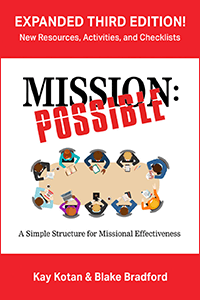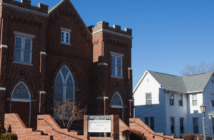Blake Bradford shares how smaller congregations can use their unique giftedness to fulfill their mission. He says smaller churches can enhance their vitality by clarifying their purpose, engaging their community, leveraging relational intimacy to reach people and build disciples, and rightsizing their leadership and governance structures.
To celebrate the Lewis Center’s anniversary, we are highlighting Leading Articles — some of our most popular posts of the past 20 years. We are pleased to share again this article by Blake Bradford, originally published on November 17, 2020.
Every church, large and small, has a God-given potential to make a God-sized impact. But differently sized congregations have different challenges. While most leadership advice is aimed at the midsize congregation, the vast number of congregations (over 80 percent in my area) are smaller congregations with average worship attendance of 100 or less. And smaller congregations thrive in different ways than their larger sister churches.
These four strategies can help a small church be vital and vibrant.
1. Clarify an impactful purpose.
Too many congregations see their purpose and identity in gathering for Sunday worship with family and friends in a beloved sacred space. But gathering on Sunday is not and never has been an adequate “why” for Christians. Clarifying your purpose doesn’t require a long, drawn out visioning process that results in a three-paragraph mission statement no one can remember. Nor is the solution imagining a plethora of programs and events, staff for every age group, and a ministry catalog as big as a phone book. Instead, small congregations should focus on one key ministry area where they can make a God-sized impact. It could be a laser focus on being a neighbor to the homeless, or connecting the arts to discipleship, or being a church that is seeking justice and reconciliation. With this impact in mind, you can align your budget, your volunteers, and your resources to make that purposeful impact a reality.
2. Engage your community with focus.
In my first appointment as a solo pastor in a small Arkansas congregation in a midsize town, I was under the mistaken impression that I was supposed to pastor the church. Not much was said about the community. I never even walked across the street, and no one in the congregation cared or asked me about it.
A fruitful, Christ-centered, and grace-filled outreach ministry is not really about what we do to or for people. Community engagement means relationships. Checkbook charity and blessing boxes on the curb are not a replacement for the Good News of Jesus Christ. Any organization can do charity work, and many excellent organizations do wonderful and essential charity. What differentiates the church from other charity or social groups is that we are in the Jesus business. Plan now for changes to your congregation’s missional outreach to make it more relational and impactful.
3. Leverage the relational intimacy of the small church to reach people.
Small and midsize churches will never be able to “compete” with megachurches in the diversity and quality of programs. But they can always “outrelate” them. Programs and buildings don’t make disciples. God uses disciples to make disciples. Larger churches need to have large systems for intentional discipleship, but small churches can grow disciples more simply. Instead of multiple classes and curricula, the small church can lean into its inherent intimacy. Small congregations are perfectly situated to make following Jesus Christ personal.
In a season of suspicion of large institutions and in the midst of the health concerns of large gatherings, small churches can offer authentic, intimate relationships. But it’s important to acknowledge that intimacy comes with the risk of only engaging in relationships with the people we already know. I once visited a church where a member introduced herself by saying, “I’m a bit of a newcomer here. We only moved here 20 years ago.” I chuckled until I noticed that no one else was laughing. She was still a newcomer, and I got the impression that they weren’t letting her forget it. To fight this natural human tendency, every member of your church needs to be equipped and charged as a relational matchmaker, connecting guests with others, inviting them into group conversations, and not letting our existing friendships become barriers for the new and uninitiated.
4. Simplify and rightsize your lay leadership and governance.
I once visited a congregation that maintained all the same committees from their golden era when the church was 400 percent larger. Even though the congregation had become much smaller, the same leaders where attempting to keep the same committee structure afloat. Ministries were ineffective and the members were exhausted. Meetings are not ministry!
A simplified leadership structure can make a small congregation more mission focused and nimble in addressing opportunities and challenges. (See Mission Possible: A Simple Structure for Missional Effectiveness, Kay Kotan and Blake Bradfield, Market Square Books, 2019.) Releasing dozens of leaders from endless administrative meetings allows them to focus their leadership gifts on missional ministries. In a small church, gaining just five or six leaders for ministries can turn around the whole future of the congregation.
Your congregation has unique gifts from the Holy Spirit and a unique mission field to transform for Jesus Christ. As a small congregation, you also have the benefits of intimacy, authenticity, and simplicity. Stay on purpose, stay connected to your neighborhood, leverage your gift of intimacy, and rightsize your leadership structure to unleash disciples into ministry. Your small church is a gift from God.
 This article is adapted from a workshop Dr. Bradford delivered at the United Methodist Church of the Resurrection’s 2020 Online Leadership Institute.
This article is adapted from a workshop Dr. Bradford delivered at the United Methodist Church of the Resurrection’s 2020 Online Leadership Institute.
Related Related
- Misson Possible 3+ (Market Square Publishing, 2021) by Kay Kotan and Blake Bradford, available at Market Square Books and Amazon.
- What is Your Signature Ministry? by Phil Schroeder and Kay Kotan
- Leadership and the Small Membership Church by Lovett H. Weems Jr.
- Doing Community Ministry in the Small Church by Joy F. Skjegstad







